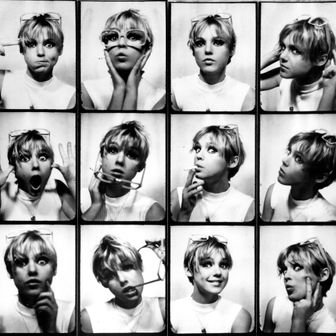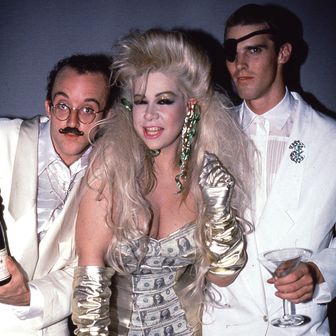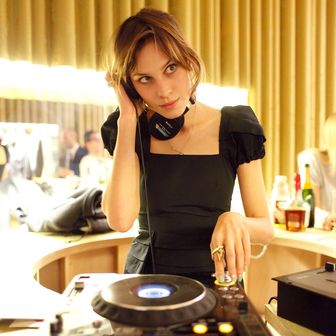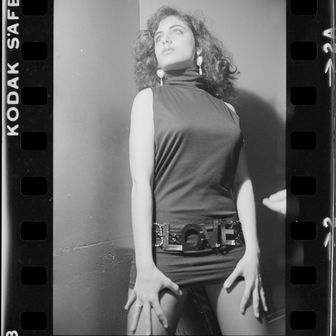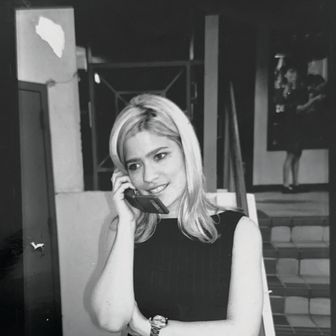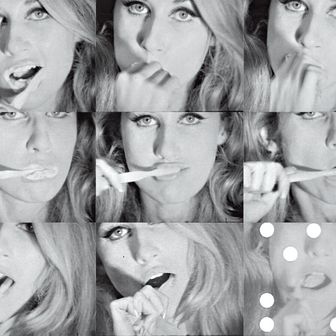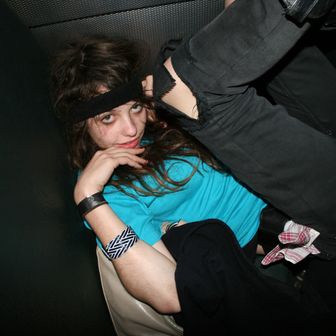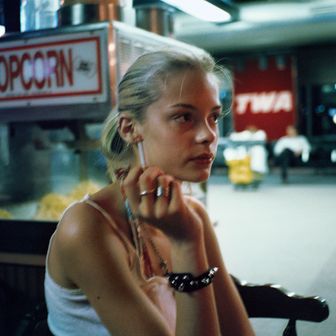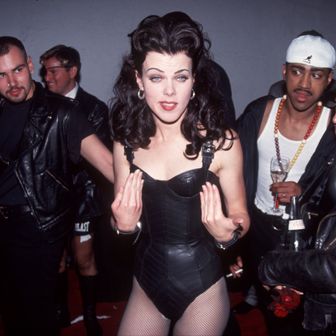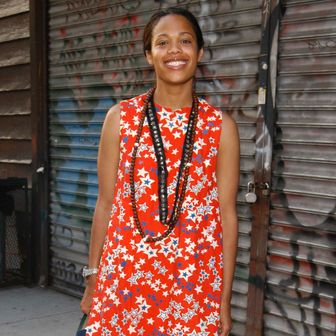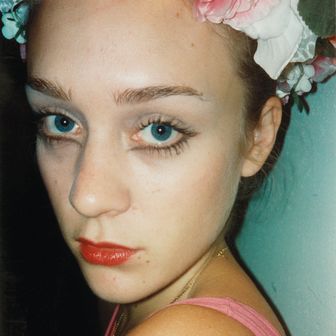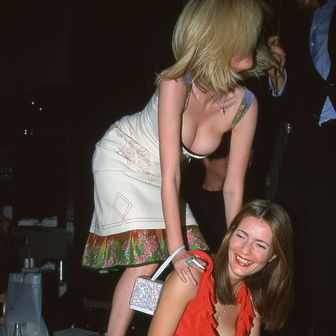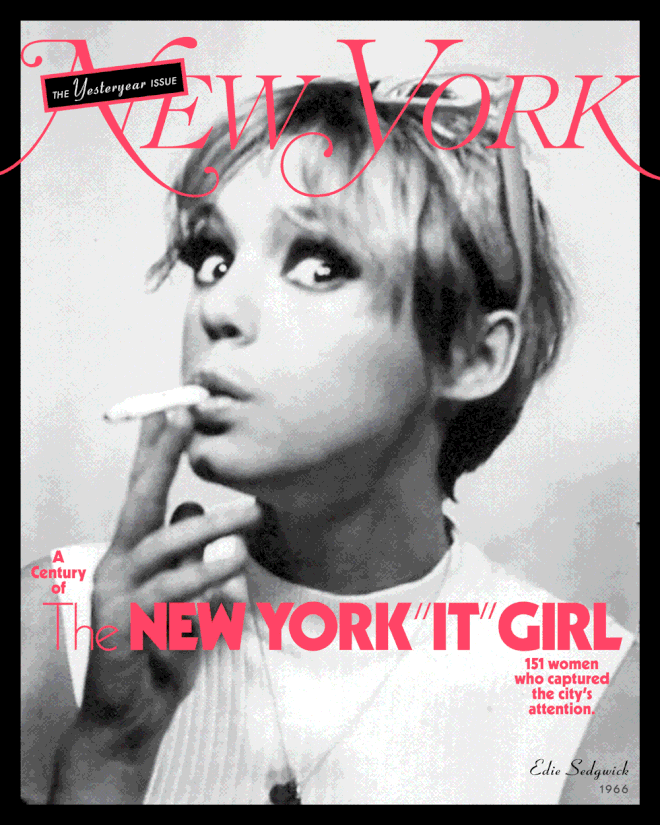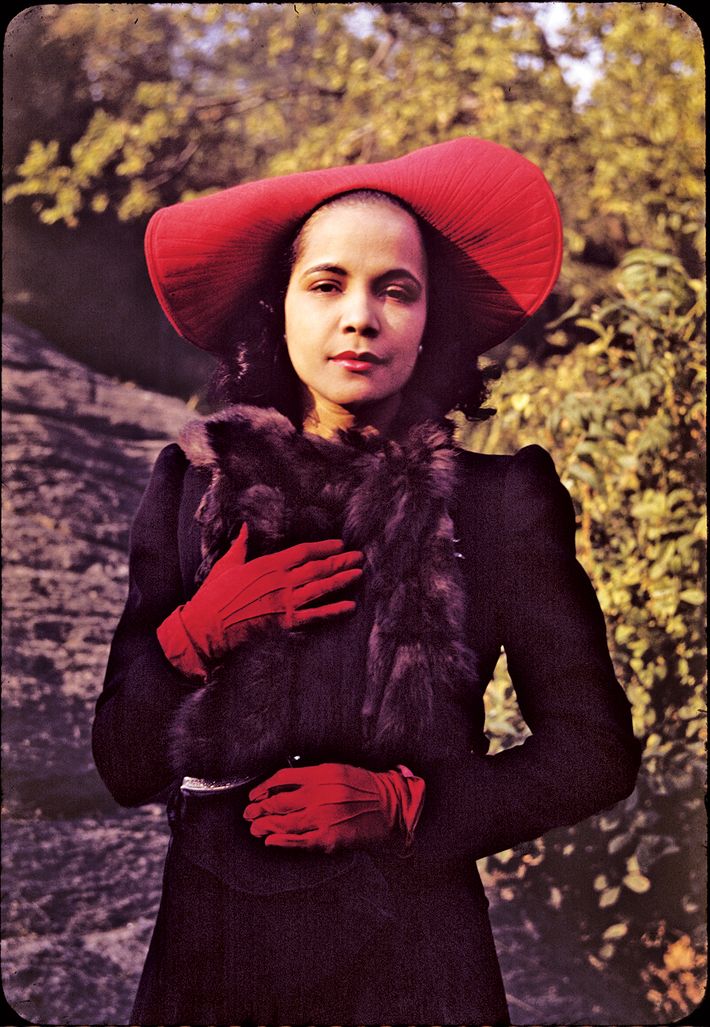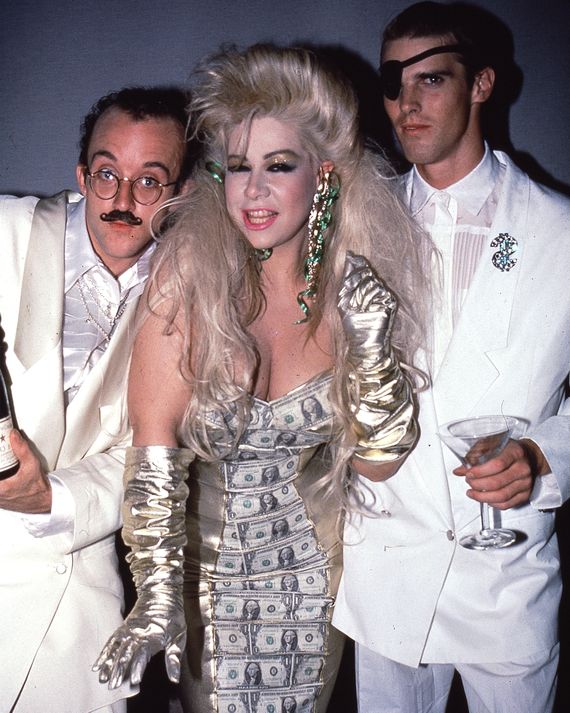
On August 22, 1985, a woman with a She-Ra mane and a latex dress appeared on Late Night With David Letterman. Letterman, still spiky in his salad days at NBC, was charmed but befuddled as he interviewed her. Unlike many of his guests that season — Johnny Cash, Teri Garr, Eddie Murphy — Dianne Brill’s qualification for the spotlight was hard to describe. True, her photograph was on the cover of that morning’s New York Post; Letterman had a copy. But still, he seemed unsure who she was. Or, as he was compelled to ask her about her front-page placement, “Why are you there?”
Letterman acknowledged that Brill was “known in New York as ‘Queen of the Night’” — what had been called, and would be called again, many times, an “It” girl. New York mints these women: famous for being out, famous for being young, famous for being fun, famous for being famous. Letterman was still confused. “Uh, Dianne, tell me about the Queen of the Night,” he said. “How do you get to be? Is this an elected position, you were appointed by the mayor, or what happens?”
Cover Story
“As a matter of fact, I met Mayor Koch,” Brill answered gamely before venturing an explanation of her title. “I think what it means is that I’m a cheerleader. I’m a downtown, uptown, midtown cheerleader. I go everywhere.” And then Brill laid out, in essence, the rules of engagement: You go out every night. The best time to show up is the peak of the party. The peak of the party is a mood. The question is not always when to come but when to leave — and that time is once you’ve said “hello” to everyone. You exit discreetly. “And then,” Brill said, “the party crashes. And they think obviously you’re the one who made the party because all of a sudden, when you leave, the party’s down.”
All of a sudden, when you leave, the party’s down. There, in a koan and a credo, is as good a working definition of “It” as we are likely to encounter.
At the risk of saying more and understanding less, let’s add a few details. “It” girls are primarily young — not exclusively; you could make a decent case for Iris Apfel’s having become an octogenarian “It” girl in the mid-aughts — but going out voraciously is a prime determinant of “It,” and a youthful energy helps. So does a sense of style, especially one unto yourself. A job is not a requirement. It’s more “It” to have either two jobs or no jobs; a bit of mystery is very “It,” and if no one can quite figure out what you do, so much the better. “People never know how to describe me — what I am,” Sally Randall, a Palladium doorgirl and post-Brill ’80s “It” girl, told this magazine in 1985. “They say, ‘You have to see it.’”
The “It” girl has been defined not by herself — to seek “It,” at least publicly, is not very “It” — but by her chroniclers: magazine writers, newspaper columnists, photographers. She is someone “everyone is drawn to — someone people want to gossip about,” says Patrick McMullan, the nightlife photographer who for nearly 40 years has been a fixture of the New York scene.
“An ‘It’ girl is an amateur in all things,” says the novelist Jay McInerney, who wrote one of the foundational texts of ’90s “It,” a New Yorker profile of a 19-year-old waif named Chloë Sevigny. “You know, a sort of supreme dilettante.” At the time, Sevigny was a supreme dilettante: She’d appeared in a Sonic Youth music video, walked Kim Gordon’s X-girl show, and was filming Kids with Larry Clark and Harmony Korine. “I honestly never thought she would become an actual actress,” McInerney says. “She just seemed to exist in the moment and to not have any grand ambitions and yet to have so much style and so much charisma and so much influence.” Although she remains eternally cool, Sevigny at this point is too professionally established and too well known to count as an “It” girl anymore. Contrary to popular use, “It” requires not only some degree of fame but also the right leavening of obscurity. An undeniable celebrity is not an “It” girl.
“I’ve always considered it a derogatory term,” says William Norwich, who wrote gossip columns for the New York Daily News and the Post beginning in 1985. Like the label socialite — also verboten — “It” girl can be reductive, demeaning, and, insofar as it has no real male equivalent, sexist. But it may also be that “It” girl is less sexist than gendered, a category created for women by women. Maybe the single biggest change in the colloquial use of the phrase since its origins in the 1920s is its surprising segregation from the male gaze. While “It” was once defined as a kind of sexual magnetism, in current usage “It” is about a type of ineffable charisma, as determined by women (and gay men).
Being chosen as an “It” girl had its hazards, including the sudden interest of middle-aged male photographers and journalists. And while youth made these girls vulnerable, getting older presented its own problems. “I don’t know how to put this delicately, but there’s a shelf life to being an ‘It’ girl,” Roger Padilha, who has written several books about New York’s art-world scene, says. The “It” girls know this. “It’s a season, and you’re aware of it,” says Bonnie Morrison, who worked as a publicist-about-town when she was “It” in the early aughts. “You look at the women who are five years older and you think, I don’t want to be like them.”
Why, then, devote our annual “Yesteryear” issue to “It”? Because “It” is one of New York’s renewable resources and New York one of “It” ’s deepest wellsprings. Because “It” changes as we change but stays itself. Because “It” requires many of our cardinal virtues, some of which seem to be endangered: tirelessness. Presence. Perceptiveness. Shamelessness. Frippery and grit.
“I don’t think you go out and say, Oh, I’m gonna become a New York ‘It’ girl,” Brill says today. “Maybe they do that now with Insta, but an ‘It’ girl is really something organic. It’s just something that happens. It happens from a need — something you’re giving and something you’re taking. I’ve always loved that about New York, that you can give and take as much as you want. New York really just says, ‘Give it to me. I’ll take it — give it.’”
You can learn a lot about a place by looking at what it can’t look away from. “It” fame offers a girl-shaped reflection of the spirit, fears, and aspirations of the day — one reason “It” girls so often find themselves the objects of media fascination. We’d no more expect the “It” girls of the ’30s to hypnotize the city of today than we would a cup of coffee to cost a nickel. They also reflect the prejudices of their moment, which is why most “It” girls were, and remain, thin, white, and, at least publicly, straight.
The use of “It” as such is generally credited to a 1927 novella by Elinor Glyn, which was turned into the silent film It, starring a redheaded flapper named Clara Bow. Bow is Betty Lou Spence, a plucky shopgirl in Waltham’s department store who clearly has what a title card informs us is “It”: “That quality possessed by some which draws all others with its magnetic force.” Betty Lou’s force is so magnetic that it yanks the store’s princely heir apparent, Cyrus T. Waltham, from his family-approved society girlfriend and into Betty Lou’s waiting arms. With her pert charm, she is, as another character memorably remarks via intertitle, “topheavy with ‘IT.’”
The film made Bow into a star, known ever after as the “It” girl. (She received as many as 30,000 letters per month in the late ’20s, some addressed simply to “The ‘It’ Girl, Hollywood, U.S.A.”) But while Bow remained on top for a few years, hers was to be a short reign, like those of many “It” girls to follow. In 1931, she married and moved to a ranch in Nevada. Her last picture was released in 1933.
When she disappeared, the phrase “It” girl (capitalized or not, with or without the quotation marks) went with her. It appeared very seldom in print during the next several decades; when it turned up in the New York Times’ crossword a few times in the late ’50s and early ’60s, its clues referred specifically to Bow. The paper of record didn’t untie “It” from Bow until the late ’70s, when it was trotted out to describe Diana Ross. In this magazine, the term began appearing regularly in the early ’90s, around the time a biography of Bow was getting widely reviewed.
In all but name, though, “It” girls never went away. In 1938, Life put Brenda Frazier, a Boston debutante, on its cover along with this explanation in the accompanying article: “With her long hair, her vivacity, and splendid figure, she is superbly photogenic, and publicity is the life blood of the new society.” In an environment where few wealthy women worked, the qualities that marked a deb — looks, connections, grace — were all that were demanded of an “It” girl.
Fame didn’t become Frazier. She struggled with anorexia and bulimia, attempted suicide, and returned to the pages of Life in 1963 to write “My Debut — a Horror.” As she aged out of girlishness, the world moved on, until the last remnant of her famous photogenicity was twisted into a grotesque portrait by Diane Arbus, who in 1966 captured her at home in bed, a vacant ghost of “It” girls past.
The modern iteration of “It” began, as did so much else, with Andy Warhol. The democracy of the Factory allowed plenty of people from less affluent backgrounds to make a home there — from Joe Dallesandro to Candy Darling — but among Warhol’s “Superstars” and “Girls of the Year,” two of the most famous, Edie Sedgwick and Baby Jane Holzer, were society girls slumming downtown. Sedgwick, who was raised in California, was a troubled trust-funder. Holzer was a daughter of privilege who married a real-estate heir.
But these were not their mother’s debs. Tom Wolfe, who memorialized Baby Jane in the New York Herald Tribune as 1964’s Girl of the Year, called her a new kind of celebrity, both a guide to her own moment and an influence on it. “The press watches Jane Holzer as if she were an exquisite piece of … radar,” he wrote. “To the magazine editors, the newspaper columnists, the photographers and art directors, suddenly here is a single flamboyant girl who sums up everything new and chic in the way of fashion.”
The Girls of the Year epitomized a fetish for youth, the sense that, after the battering of the wartime ’40s and the stale calm of the ’50s, change was going to come from the new generation. Diana Vreeland, the editor of Vogue, coined the term youthquake for the phenomenon in 1965, the year after Sedgwick moved to New York. She became a favorite of Warhol’s soon after, and when she accompanied him to openings, crowds formed. She had her own memorable style — a silver-blonde crop haircut, a preference for minidresses and black tights — and appeared in 18 Warhol films. But her real talent, like “It” girls back to Bow, was for being famously herself.
A taste for youth and novelty, however, cuts both ways. After Sedgwick abandoned Warhol for an aborted romance with Bob Dylan, Warhol dropped her. In 1968, observing that “It” girls “come and go so fast that nobody ever stops to wonder what happened to last year’s girl,” a Post reporter rang up Warhol in search of her only to be told, “I don’t really know where she is. We really were never that close.” Sedgwick descended into drug use and died in 1971 at 28.
At the Factory, though, new girls followed the old. In 1974, Bob Colacello began writing “Out,” a column that could make a woman a star, for Warhol’s Interview magazine. He covered a new guard of globally glamorous “It” girls, avatars of the jet set as jetting was becoming commonplace, women such as Bianca Jagger and Diane von Furstenberg. (In 1973, New York ran a cover story on von Furstenberg and her then-husband: “The Couple That Has Everything. Is Everything Enough?”) These “It” girls partied with Warhol at Studio 54, which opened in 1977, and wound up on the cover of his magazine: vertically integrated “It.”
After Reagan was elected, “It” split into an uptown scene of society women and a downtown scene of clubgoers. Once a necessity for “It,” wealth became merely (merely!) a common accessory: An “It” girl could be a debutante or a demimondaine. For a time in the mid-’80s, the Daily News employed two social columnists: Norwich covered uptown (Cornelia Guest, Princess Gloria von Thurn und Taxis, and the Tisches), and Dinah Prince wrote about downtown (Cookie Mueller, Brill, and Tina L’Hotsky, the “Queen of the Mudd Club”).
The two sides appeared to be near opposites. “There was enormous exchange between Park Avenue and the Reagans,” says Norwich, and for many of the uptowners, Nancy was “their queen.” For the uptown “It” girls, “the ’80s became the new Gilded Age,” says Colacello, who left Interview in 1983 and began writing for Tina Brown’s Vanity Fair, which in 1985 splashed the Reagans dancing in black tie on its cover. “It became more about plutocracy and money and society in a more old-fashioned way.” Time profiled Guest in 1983 as she prepared to sing at the disco Xenon, but still readily acknowledged “her debutante splash would have been unthinkable only a few years ago … These days it is once again fashionable to flaunt the traditional, frivolous perquisites of wealth and class.”
Some saw a parallel frivolity in the downtown scene — Susan Morrison, an editor at Spy, called Brill “a subterranean doppelgänger of Pat Buckley” — but it was younger, queerer, druggier, and more threadbare. It had its own haunts (the Pyrami d Club, AREA, and Danceteria) and its own social columns (Stephen Saban’s in Details and Michael Musto’s in The Village Voice). It even had its own philanthropy: An ad hoc “Downtown Chorus,” including Brill, RuPaul, and a soon-to-be-infamous Michael Alig recorded a benefit song to raise money for AIDS, while uptown still mostly considered it “the hairdresser’s disease.” (The song, naturally, was Petula Clark’s “Downtown.”)
The club kids of the late ’80s and early ’90s represented the “It” id about as unbridled as it would ever get, dressing outlandishly to spook the normies: Alig, James St. James, and Jenny “Jenny Talia” Dembrow were frequent guests on daytime talk shows, where Geraldo et al. would lament their druggie decadence. The club kids had their own clubhouses — the World, Tunnel, Limelight — and their own house photographer in Walt “Waltpaper” Cassidy. (They also had, in Alig, a tragic anti-hero who nearly ended the scene when, in 1996, he and a friend murdered and dismembered a fellow club kid named Angel Melendez.)
Members of a more polished downtown social set found themselves at Lot 61, or Spa, or Moomba, where Leonardo DiCaprio would bring his model of the moment. They had their own people’s princess in Carolyn Bessette, a former Calvin Klein publicist who married John F. Kennedy Jr. in 1996. Throughout the ’90s, Anna Wintour’s Vogue was their bible and, often, their employer, as it was for Lauren Davis (later Santo Domingo) and Plum Sykes, an English expat who moved to New York in 1997, a few years after her twin sister, Lucy. The system fed the system — yet more vertical integration: “It” girls covered “It” girls for the magazines read by “It” girls. It could be hard to tell who was observing whom. “I went to every single party they went to, and because I was at those parties — even though I went with my notebook and Perrier in my Champagne glass because I was working — I appeared to be one of them,” Plum Sykes says.
At the beginning of the new century, much of the “It” beat moved online. In 2001, Condé Nast launched style.com, which exhaustively chronicled runway shows and the social events surrounding them. (Several years later, I was an editor there.) An “It” girl might turn up in two or three or four of these recaps a week, kicking off a virtuous cycle of “It”: Organizers read the site as much as partygoers and put together guest lists based on who was getting attention. “Suddenly, I was invited to these things where I would never have been invited,” says Jill Kargman, who wrote style.com’s “EyeSpy” social column. “People wanted exposure.” She described her social ascent as “shit to Champagne” — though it bears noting that her father was president of Chanel at the time.
A new class of internet-savvy “It” girls rose to prominence, fighting for the top slot on Socialite Rank (a briefly anonymous website launched in 2006 by a pair of Russian stepsiblings that caused delight and fury) and Park Avenue Peerage (a briefly anonymous website launched in 2007 by an Illinois undergraduate that caused delight and less fury). The internecine fights of this sequined world — Tinsley Mortimer versus Olivia Palermo being the knockdown of them all — took easily and well to the workday blog scroll.
Meanwhile, the downtown faction endured at Club Chrissie, an apartment a block away from the scuzz bar of the day, Lit, generating blurry after-party photos that put the sleaze in indie sleaze. For those who found themselves crisscrossing the two worlds — Club Chrissie one night, a boutique opening the next — the spotlight could be gratifying but also disorienting. “I don’t know if hate is the right word, but I felt uncomfortable,” Jen Brill (no relation to Dianne), one of the preeminent “It” girls of the style.com aughts, says. “I’ve always worked, and I’ve always had a career. And I was worried people thought I only went to parties.” But she was going to parties most nights, and the world noticed. Walking down the street with James Franco one day, “this girl started running toward us,” she says. “Both of us 180 percent thought that she was about to fan out on him. And she was like, ‘Jen Brill, I love your style!’”
Brill eventually “tapped out” of the scene. “What’s the next level for an ‘It’ girl?” she asks. “What do you parlay it into?” Brill, who is Chinese, points out that she was one of the few “It” girls of color at the time. “I think that’s why people got excited to see me and excited that I was playing the game to begin with,” she says. If the balance was shifting, it was still nowhere near to equal. Bonnie Morrison, who is Black, recalls that after a profile of her appeared on a blog called the Mocha Socialite, she got letters and emails from young Black women asking how they could follow in her footsteps.
After Facebook ate the media, “It” girls no longer needed to coax the press or the blogosphere into writing about them (or to hire publicists to coax or protest on their behalf). Nor did they have to join the press to write about themselves and one another. They could be their own bully pulpits, their own gazetteers. On social media, they could offer any interested followers instant access and their own homespun spin.
The “It” girls of the 2010s didn’t want to be photographs, stilled into silence, talked about and around. Many wanted to be CEOs or brands or both. Those who rose to the top of the conversation were those who controlled the conversation: women like Emily Weiss of Into the Gloss and Glossier and Audrey Gelman of The Wing. Unlike in the sad stories of earlier generations, here were women who used their status to achieve financial stability, if not always lasting good favor.
In the social age, “It” girls are now expected to interact, share, and opine. “In the old days” — i.e., the aughts — “there was this patina,” says Kargman. “You could hide behind the artifice of your party dress and an air-kiss and a flashbulb. If you knew everyone’s politics, you might not like what you found.” These days, the UNFOLLOW button is always close at hand.
Not every influencer is an “It” girl, but every “It” girl has the tantalizing possibility of being an influencer — and companies have popped up to broker the transformation. Browse through an “It” girl’s Instagram and the telltale #partner tag will inevitably bubble up.
“It” has always had an onus of influence (women bought up strapless gowns to emulate Frazier and shopped Halston to get a little of the glamour of his Halstonettes), but the girls themselves haven’t always been able to avail themselves of the profits. Today, any “It” girl worth her following has a modeling agent and a manager, and the mystery and nicheness that were once an elemental part of “It” — the secondhand “It” you got just from knowing who an “It” girl was — are on the wane.
This marriage of “It” and hustle culture means that contemporary “It” girls are unlikely to descend into penury or have to marry millionaires to stay afloat. But they’ve also lost some of the scene-for-scene’s-sake freedom their ragtag ancestresses had. “You can always be remembered if you’re original and you do something with no money,” says John Waters, who committed his fair share of broke “It” girls to celluloid. Cookie Mueller, who appeared in Pink Flamingos and Female Trouble, “didn’t even seem to want to be rich, to be honest,” he says. “That matters a lot.” Of course, it’s easier to not want to be rich when you’re paying Nixon-era prices. In 1973, the Voice could advertise 875-square-foot lofts on Great Jones Street for $229 a month, or $1,580 in 2023 dollars. These days, 800 square feet on Great Jones will cost you three times that — if you can find it. In Dimes Square, the “It” girl’s latest launchpad, the appearances and appurtenances of bohemia still reign, but so do $24 salads and a new $525-a-night hotel.
Does true “It” resist such packaging? Or is that one more fantasy we can no longer afford? “It,” for all its apparent effortlessness, has always had a hustle lurking somewhere, whether that takes the form of an underlying trust fund, a waiting fiancé, or the expectation of a movie deal or modeling contract. Often, those who don’t mind the bottom line are the ones who suffer the most. And lest we forget, there was nothing all that pure about the scene in the first place. “When people say, ‘What would Andy be doing if he were here today?’” Colacello tells me, “I say, ‘He would be dating Kim Kardashian and telling me I had to put her on the cover of Interview.’”
More on the New York ‘It’ Girl
- ‘It’ Girls in Conversation: Anaa Saber, Maria Al-sadek, and Friends
- Today’s ‘It’ Girls in Conversation: Imani Randolph & Friends
- ‘It’ Girls in Conversation: Ivy Getty and Friends


